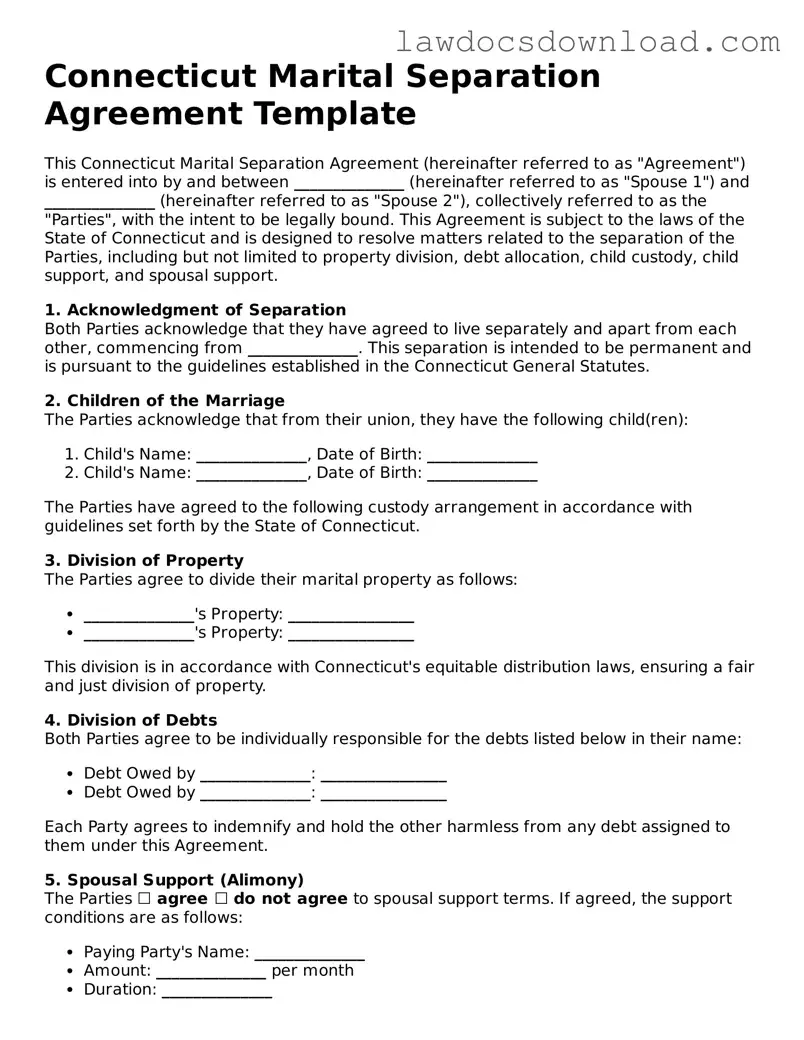Connecticut Marital Separation Agreement Template
This Connecticut Marital Separation Agreement (hereinafter referred to as "Agreement") is entered into by and between ______________ (hereinafter referred to as "Spouse 1") and ______________ (hereinafter referred to as "Spouse 2"), collectively referred to as the "Parties", with the intent to be legally bound. This Agreement is subject to the laws of the State of Connecticut and is designed to resolve matters related to the separation of the Parties, including but not limited to property division, debt allocation, child custody, child support, and spousal support.
1. Acknowledgment of Separation
Both Parties acknowledge that they have agreed to live separately and apart from each other, commencing from ______________. This separation is intended to be permanent and is pursuant to the guidelines established in the Connecticut General Statutes.
2. Children of the Marriage
The Parties acknowledge that from their union, they have the following child(ren):
- Child's Name: ______________, Date of Birth: ______________
- Child's Name: ______________, Date of Birth: ______________
The Parties have agreed to the following custody arrangement in accordance with guidelines set forth by the State of Connecticut.
3. Division of Property
The Parties agree to divide their marital property as follows:
- ______________'s Property: ________________
- ______________'s Property: ________________
This division is in accordance with Connecticut's equitable distribution laws, ensuring a fair and just division of property.
4. Division of Debts
Both Parties agree to be individually responsible for the debts listed below in their name:
- Debt Owed by ______________: ________________
- Debt Owed by ______________: ________________
Each Party agrees to indemnify and hold the other harmless from any debt assigned to them under this Agreement.
5. Spousal Support (Alimony)
The Parties ☐ agree ☐ do not agree to spousal support terms. If agreed, the support conditions are as follows:
- Paying Party's Name: ______________
- Amount: ______________ per month
- Duration: ______________
The determination is made in reflection of Connecticut's guidelines for spousal support.
6. Child Support
In accordance with the Connecticut Child Support Guidelines, the Parties agree to the following terms for child support:
- Paying Party's Name: ______________
- Amount: ______________ per month
- Duration: Until the child reaches the age of 18 or completes high school, whichever is later.
This Agreement represents a shared and mutual understanding between Spouse 1 and Spouse 2 regarding their separation and aims to ensure an equitable resolution of their matters. Both Parties have had the opportunity to seek legal advice before entering into this Agreement.
Executed this _____ day of ______________, ____.
Spouse 1's Signature: ________________________________________
Printed Name: ______________
Spouse 2's Signature: ________________________________________
Printed Name: ______________
